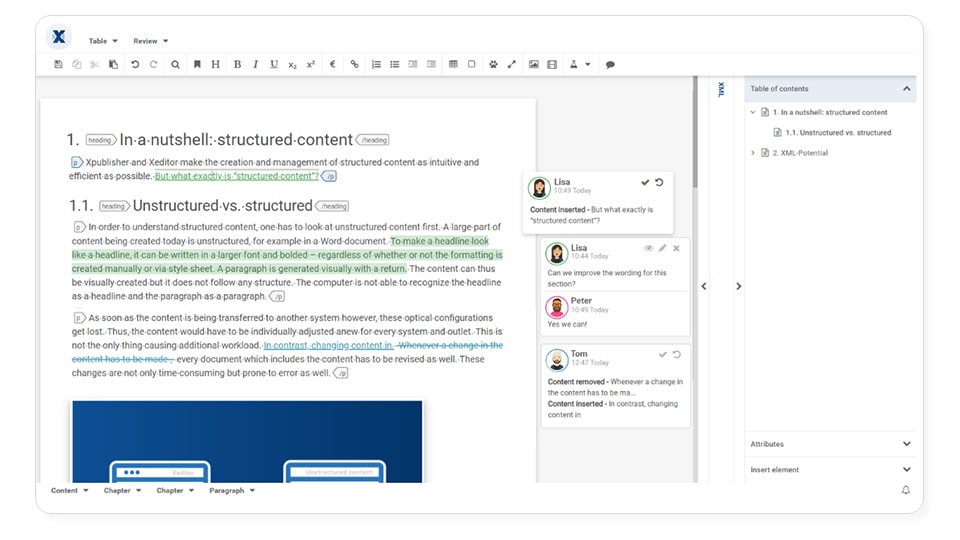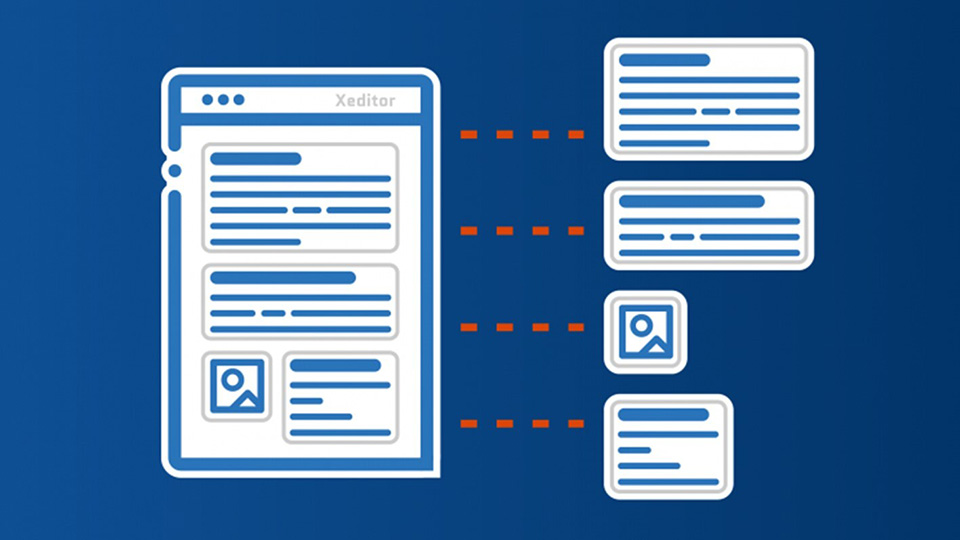Structured content is becoming increasingly relevant, and many analysts and experts see it as the key to document creation in the future. But what does this term really mean, and what are its advantages compared with unstructured content? This article answers those questions and visualizes the concept of structured content in a video, using the example of a cooking recipe.
1. What is structured content?
Structured content is text or text modules that authors and editors create based on a fixed structure such that the text is enriched semantically with metadata. This makes text “cross-media capable,” meaning it can be published and used on any output channel and serve as the basis for efficient multichannel publishing.
XML (Extensible Markup Language), a markup language for mapping hierarchically structured data, is the global standard for this. XML can be read by humans and machines alike. To create the content, companies and authors use professional XML editors.
2. Structured vs. unstructured content
Authors working in Microsoft Word work largely without a defined structure, formatting content as they see fit. They use larger fonts or alternate formatting options to accentuate headings visually, and line breaks to separate paragraphs. This produces unstructured or non-standardized documents that machines can’t interpret.
This kind of unstructured content creates challenges when it comes to publishing across multiple channels. The author has to adapt the content to each particular channel every single time. Besides being time-consuming, the process is also error-prone.
Contrast that with structured content – structured both on the surface in how the text has been styled visually, and semantically beneath the surface, to make the content machine-readable. An underlying set of rules (say, an XML schema such as DITA, S1000D, JATS, or LegalDoc) specifies the structure of the document and explicitly defines what a heading, a paragraph, a table, or a graphic is and how they are formatted. Authors focus exclusively on creating their texts, without being distracted by their eventual layout or target channel.
3. A quick look at the benefits of structured content
Along with giving authors and publishers the ability to efficiently repurpose content on any channel, structured content offers even more advantages:
- A high degree of consistency and standardization: The underlying set of rules (XML Schema or Document Type Definition) ensures that authors create their content based on common specifications.
- Efficient multichannel publishing: Thanks to its cross-media capability, structured content can be published quickly and easily to a variety of channels.
- Maximum reusability: Structured content can be broken down into individual fragments or building blocks and then integrated into multiple existing or new products and publications.
- Save time on content updates: Authors edit the texts and text modules in a single place, so that all products and publications that use those modules are automatically updated as well.
- Content discoverability: Semantically tagging content with metadata makes it easier to locate. It makes information more readily available to the people who need it.
4. How is structured content created?
User-friendly XML editors such as Xeditor provide authors with the ability to create structured content. And they don’t require authors to have any special IT skills to do so. In the past, structured content creation was reserved for technical writers, but today’s web-based XML editors feature a Word-like user interface.
Based on the principle of “guided authoring,” the XML editor guides the author intuitively through the content creation process and validates input in real time based on the defined XML schema. The change tracking and comment features support location-independent teamwork. The following screenshot provides an insight into the user interface of Xeditor:

5. A visual example: The recipe
Cooking recipes are generally fairly easy for us humans to understand. They include a list of ingredients and step-by-step instructions for preparation. The individual components of the recipe, including quantities such as grams and liters or cups and teaspoons, are easy for us to interpret. But machines and output channels (such as websites, web portals, or Adobe InDesign) will only understand the content if the author uses XML to semantically mark it up (for instance, by tagging content as “quantity”) during the authoring process.
When these recipes are available in a structured form, further advantages arise in addition to their reusability across different channels. For one thing, it is easy to update or recalculate the ingredient list at the touch of a button, to accommodate the desired number of servings.
In this video, Xpublisher CEO and structured content expert Matthias Kraus explains how structured content works, using the example of a recipe for spaghetti carbonara (note: this video is available in German only).
6. Insights from the field: Lufthansa Technik and Wolters Kluwer
The scope of application for structured content is diverse. Structured content is used by publishing houses, associations, government agencies, industrial companies, and numerous other organizations to produce editorial texts and technical documentation. In this section, you’ll learn how Lufthansa Technik, Airbus, and Wolters Kluwer are leveraging the benefits of standardized content in the real world.
6.1 Lufthansa Technik: Digital job cards
In the aviation industry, job cards serve as the basis for all of the activities in production. They are used to define and document work on aircraft, components, engines, and landing gear, and they are subject to the most stringent requirements in terms of accuracy and verifiability. To comply with these demands, Lufthansa Technik is now using the web-based XML editor Xeditor throughout the company on a large scale.
Read the Lufthansa Technik Success Story
6.2 Wolters Kluwer: Global performance gains in operations
Global information service providers such as Wolters Kluwer aim to create and publish top-quality content in the shortest possible time. The only way to achieve this is by using structured content consistently, enriching it with metadata, and ensuring efficient collaboration among everyone involved on a global scale. The desktop-based applications used by the company prior to their switch to Xeditor had reached their limits. In our success story, you’ll learn more about the advantages of a web-based XML editor and see how this company made the successful transition from a desktop-based XML editor.




